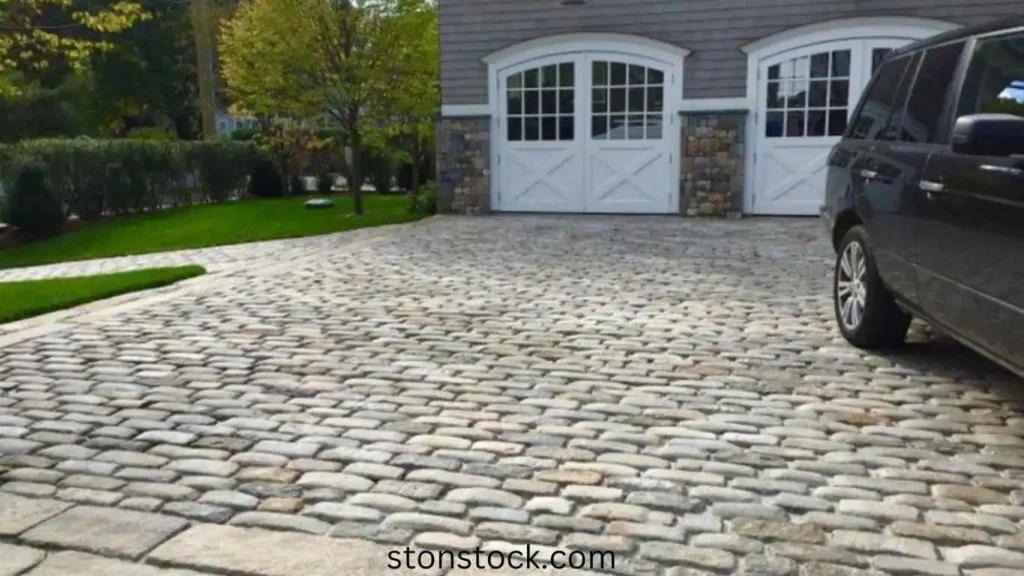Cobblestone Pavers: 10 Benefits to Use in Driveway

One of the earliest types of pavement material is cobblestone, which has a history that begins with the Romans Cobblestone Pavers. Open fields, rock quarries, and bodies of water were some of the elements that shaped the formation of these landscape stones. Driveways and paths may be paved with cobblestone pavers, which are tiny stones of different sizes and forms.
In appearance, they are typically small and round. Driveways made of stone bricks are more aesthetically pleasing and durable than those made of gravel, concrete, or asphalt. When you choose them to build your new driveway, you’re also choosing an eco-friendly option.
What is Cobblestone Paving?
Natural crushed and shaped stones are known as cobblestones. Along with gravel, pebbles, and boulders, riverbeds and seabeds are good places to find cobbles. They have softly rubbed edges and riven surfaces. But the idea of cobblestones has evolved greatly throughout the years. Cobblestones are the modern term for square or rectangular stones such as Granite Setts. Natural stone quarries are the sources of these stones.

In their gardens, driveways, and other outside areas, many homeowners choose to utilize manmade cobblestones. These pebbles are sculpted from concrete or clay. These stones have consistent forms and smooth edges because of their manufacturing process. Natural stone pavers, also known as cobblestones across the world, are the subject of our attention today, but that is for another day.
Why Should Cobblestone Be a Choice for Your Driveway Paving Project?
Cobblestone is the best material for walkways and driveways, but you may be wondering why. To have a better understanding of this stone’s benefits, consider the following aspects:.

Aesthetic Appeal
Driveways and walkways leading up to the front are purely aesthetic. When properly cared for, natural stones are visually beautiful and embellished with their inherent beauty. Your home’s resale value will rise with the installation of natural stone pavers, such as cobblestones, and this includes the driveway.
Easy to Install
The modest size and uniform shape of cobblestones make them ideal for paving paths. Two choices are available: setting in mortar or laying dry in a paver foundation. With some planning, installing cobblestones is a do-it-yourself project that requires a lot of physical effort but isn’t very difficult. Get a professional builder or stonemason on the job if you want your driveway to have intricate patterns and motifs.
Tons of Design Opportunity
Cobblestone pavers made from locally sourced stones, appropriately cut and prepared for use as kits, are an alternative to more common materials like granite and basalt.
In this way, you may have a wide range of alternatives when it comes to the design, including different layout patterns, textures, colors, and variations in stone qualities and design. You may choose from a wide variety of natural stone pavers and cobblestones at World of Stones USA.
Affordable Options Available
Whatever your budget, we have a variety of cobblestone alternatives to suit it. The installation of high-quality granites as driveway cobblestone pavers is, in fact, an expensive endeavor. Cobblestone driveways may be expensive, but using basalt, sandstone, or other locally sourced stones can save you money.
Durability
Among the many materials available for driveway building, natural stones are by far the most durable. Strong enough to endure heavy foot and vehicle traffic, they are durable. As a result of its high flexural strength, cobblestone pavers can withstand a wide range of internal and external forces. Cobblestone pavers will not easily get surface spalls when an adequate maintenance schedule is followed. Many streets in the United States attest to the fact that it may endure for generations.
Load-bearing material with Flexibility
Natural materials like cobblestone pavers have a lot of strength and can support a lot of weight. Assuming correct installation, it readily supports the weight of large trucks. In the event that the top surfaces are subjected to direct heavyweight or pressure, the grout gap allows the dry paver foundation to expand or move somewhat.
Weather Resistance
Pavers put on top of a dry paver foundation allow water to drain away easily from cobblestone roads. Additionally, by soaking up extra water, it reduces heavy ice on surfaces. The exposed grouts or joints further serve to fortify it against sand or high-wind storms.
This kind of permeability makes it easy for heat and cold to escape under the surface, which prevents overheating and saves energy throughout the freeze-thaw cycle.
Stain Resistance
Siliceous stones, such as granite, sandstone, and bluestone, have traditionally been the material of choice for natural cobblestones. Cobblestones, in contrast to calcareous stones, are resistant to stains and pH levels, making them ideal for external areas prone to oil and gasoline spills from cars.
Easy to Clean
Typically, all it takes to wash your cobblestone driveway walks is a good rain. Nevertheless, natural stones are staying clean and fresh with only a water wash every one or two months.
To clean your cobblestone driveway correctly without damaging it, use gentle detergents or cleaning solutions.
Easy to Replace
In order to set a little stone, cobblestones were used. This method allows you to simply replace the broken or cracked component. If you’re using mortar foundation or doing dry laying, however, this won’t apply. Driveways with a cement-concrete or asphalt foundation make this procedure more time-consuming and costly.

Conclusion
Consider the possibility that you may benefit from expert advice. World of Stones USA is also the place to go if you need expert advice on your next cobblestone paver project. In addition, it might connect you with additional local connections who can help with your project.







